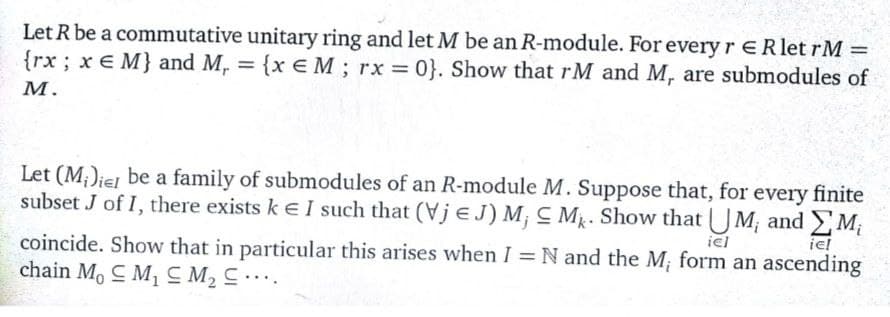Let R be a commutative unitary ring and let M be an R-module. For every rERlet rM = {rx; x E M} and M, = {x E M; rx 0}. Show that rM and M, are submodules of М.
Let R be a commutative unitary ring and let M be an R-module. For every rERlet rM = {rx; x E M} and M, = {x E M; rx 0}. Show that rM and M, are submodules of М.
Elements Of Modern Algebra
8th Edition
ISBN:9781285463230
Author:Gilbert, Linda, Jimmie
Publisher:Gilbert, Linda, Jimmie
Chapter6: More On Rings
Section6.4: Maximal Ideals (optional)
Problem 13E
Related questions
Question

Transcribed Image Text:Let R be a commutative unitary ring and let M be an R-module. For every rERlet rM =
{rx; x E M} and M, = {x E M; rx 0}. Show that rM and M, are submodules of
М.
Let (M;)iel be a family of submodules of an R-module M. Suppose that, for every finite
subset J of I, there exists ke I such that (Vje J) M¡ C Mg. Show that UM; and M;
iel
iel
coincide. Show that in particular this arises when I = N and the M; form an ascending
chain M, C M1 CM2 C .
%3D
Expert Solution
This question has been solved!
Explore an expertly crafted, step-by-step solution for a thorough understanding of key concepts.
Step by step
Solved in 2 steps with 1 images

Recommended textbooks for you

Elements Of Modern Algebra
Algebra
ISBN:
9781285463230
Author:
Gilbert, Linda, Jimmie
Publisher:
Cengage Learning,

Elements Of Modern Algebra
Algebra
ISBN:
9781285463230
Author:
Gilbert, Linda, Jimmie
Publisher:
Cengage Learning,